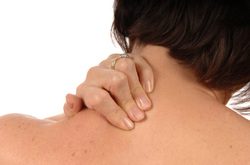
Many clients book Deep Tissue appointments simply because they a) don't want to be slathered with lotion or oil b) aren't sure what the difference is or c) have heard the "no pain, no gain" theory when it comes to massage.
But there are benefits to both Swedish and Deep Tissue massage. In fact, each modality is ideal for certain clients, depending on their age, level of activity, any illnesses or conditions and their desired goals.
Per Henrik Ling, the father of Swedish massage, developed this modality based on three techniques it employs: effleurage, (Long gliding strokes), petrissage, (kneading and twisting), and vibration, (cupping, thumping or shaking). The therapist applies these strokes using light, medium or firm pressure according to the client's wishes. Contrary to popular belief, pressure does not mean deep tissue. So Swedish does not necessarily mean a light, fluffy treatment or a liberal application of lotions or oils.
Think back to your last massage. Chances are, your therapist utilized these techniques whether you received Swedish or Deep Tissue. It's a great foundation for a deeper massage, as it immediately results in:
- increases blood flow and circulation
- relaxes superficial muscles
- warms fascia and connective tissue
- decreases blood pressure
Now onto Deep Tissue. Unlike deep pressure, deep tissue techniques are designed to release tension in muscles, connective tissue and fascia within the body. "Knots" or adhesions in the muscles, can block circulation, cause pain and limit range of motion. (Think about it! Haven't you ever had a crick in your neck that made it impossible or extremely painful to turn your head?)
Typical techniques include Swedish strokes as well as cross-fiber friction and trigger point release methods. These techniques are applied via the therapist's hands, thumbs, forearms and elbows to work the muscles beneath the superficial muscles. The benefits of deep tissue include:
- relieves chronic pain from activities (sports) or conditions
- decreases muscle tension and spasms
- increases range of motion
- improves posture
- reduces recovery time
So which do you prefer, Swedish or Deep Tissue? Let us know in the comments below!
But there are benefits to both Swedish and Deep Tissue massage. In fact, each modality is ideal for certain clients, depending on their age, level of activity, any illnesses or conditions and their desired goals.
Per Henrik Ling, the father of Swedish massage, developed this modality based on three techniques it employs: effleurage, (Long gliding strokes), petrissage, (kneading and twisting), and vibration, (cupping, thumping or shaking). The therapist applies these strokes using light, medium or firm pressure according to the client's wishes. Contrary to popular belief, pressure does not mean deep tissue. So Swedish does not necessarily mean a light, fluffy treatment or a liberal application of lotions or oils.
Think back to your last massage. Chances are, your therapist utilized these techniques whether you received Swedish or Deep Tissue. It's a great foundation for a deeper massage, as it immediately results in:
- increases blood flow and circulation
- relaxes superficial muscles
- warms fascia and connective tissue
- decreases blood pressure
Now onto Deep Tissue. Unlike deep pressure, deep tissue techniques are designed to release tension in muscles, connective tissue and fascia within the body. "Knots" or adhesions in the muscles, can block circulation, cause pain and limit range of motion. (Think about it! Haven't you ever had a crick in your neck that made it impossible or extremely painful to turn your head?)
Typical techniques include Swedish strokes as well as cross-fiber friction and trigger point release methods. These techniques are applied via the therapist's hands, thumbs, forearms and elbows to work the muscles beneath the superficial muscles. The benefits of deep tissue include:
- relieves chronic pain from activities (sports) or conditions
- decreases muscle tension and spasms
- increases range of motion
- improves posture
- reduces recovery time
So which do you prefer, Swedish or Deep Tissue? Let us know in the comments below!
 RSS Feed
RSS Feed